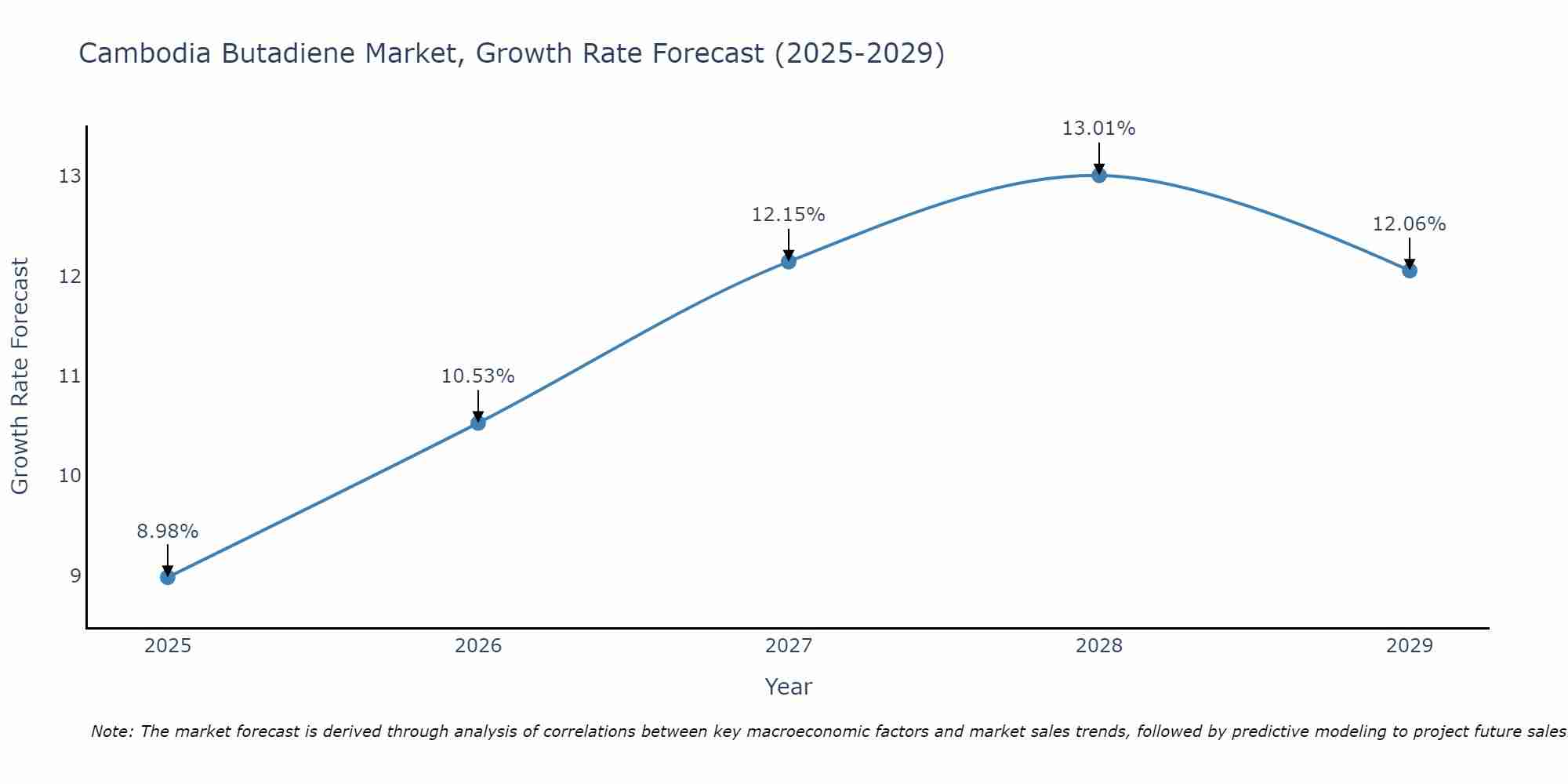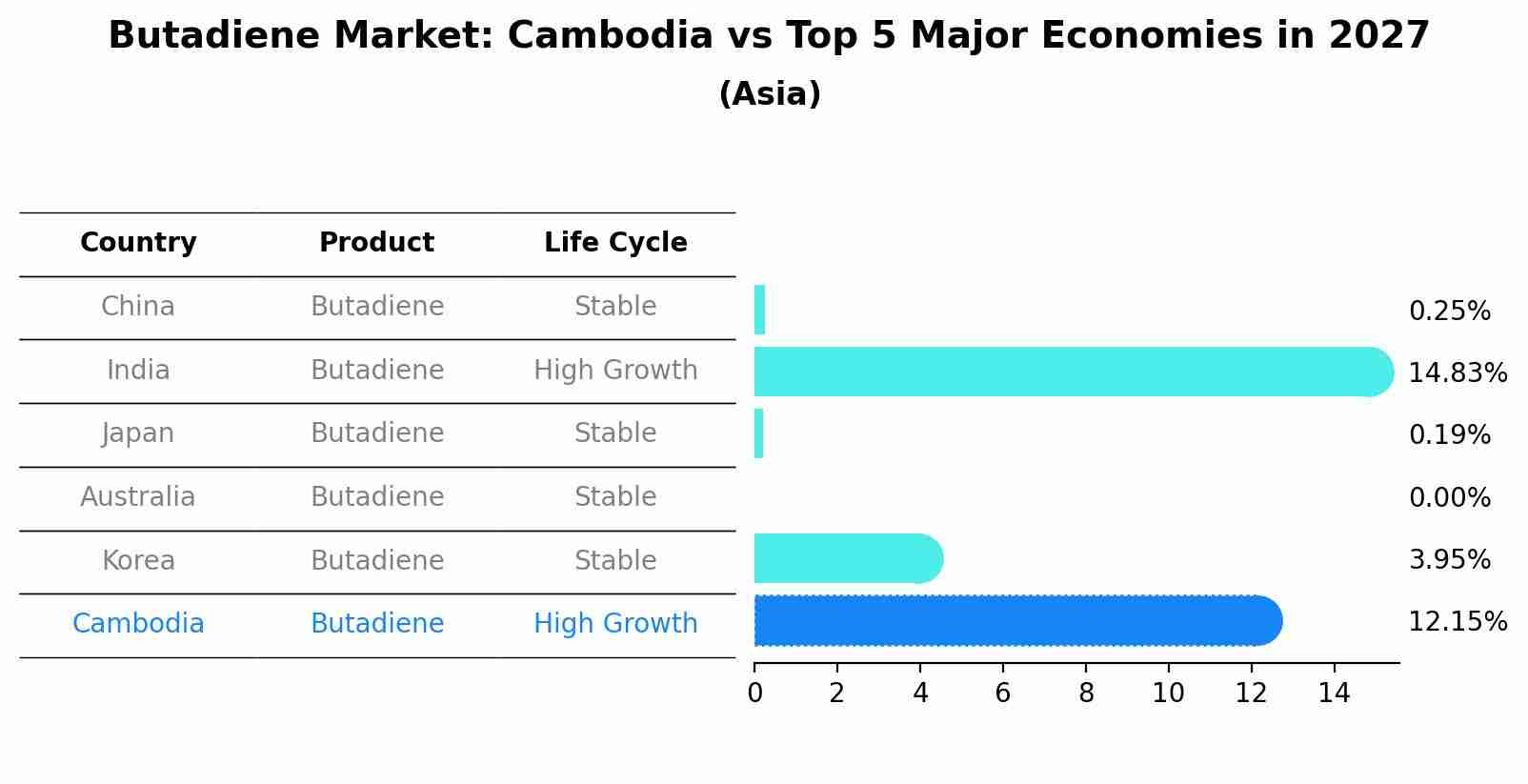Cambodia Butadiene Market Outlook | Forecast, COVID-19 IMPACT, Trends, Companies, Analysis, Value, Industry, Size, Growth, Share & Revenue
| Product Code: ETC109792 | Publication Date: Jun 2021 | Updated Date: Jun 2025 | Product Type: Report | |
| Publisher: 6Wresearch | Author: Shubham Padhi | No. of Pages: 70 | No. of Figures: 35 | No. of Tables: 5 |
Cambodia Butadiene Market Size Growth Rate
The Cambodia Butadiene Market is projected to witness mixed growth rate patterns during 2025 to 2029. Growth accelerates to 13.01% in 2028, following an initial rate of 8.98%, before easing to 12.06% at the end of the period.

Butadiene Market: Cambodia vs Top 5 Major Economies in 2027 (Asia)
Cambodia's Butadiene market is anticipated to experience a high growth rate of 12.15% by 2027, reflecting trends observed in the largest economy China, followed by India, Japan, Australia and South Korea.

Cambodia Butadiene Market Overview
The Cambodia butadiene market is experiencing steady growth driven by the expanding automotive and construction industries in the country. Butadiene is a key chemical used in the production of synthetic rubber, which is in high demand for tire manufacturing. The increasing investment in infrastructure projects and the rising consumer demand for vehicles are fueling the demand for butadiene in Cambodia. Additionally, the growing awareness of the benefits of synthetic rubber over natural rubber is further boosting the market. However, challenges such as fluctuating raw material prices and environmental concerns related to butadiene production may impact market growth. Overall, the Cambodia butadiene market is poised for continuous expansion in the coming years, supported by the country`s economic development and industrial growth.
Cambodia Butadiene Market Trends
The Cambodia Butadiene market is experiencing steady growth driven by increasing demand from the automotive and construction industries. The country`s growing economy and infrastructure development projects are also contributing to the rising consumption of Butadiene. Additionally, the shift towards environmentally friendly products and the development of bio-based Butadiene are emerging trends in the market. However, challenges such as fluctuating raw material prices and regulatory hurdles may impact market growth. Overall, the Cambodia Butadiene market is projected to continue expanding in the coming years, driven by increasing industrial activities and technological advancements in the sector.
Cambodia Butadiene Market Challenges
In the Cambodia Butadiene market, some of the key challenges faced include volatility in raw material prices, limited domestic production capacity leading to reliance on imports, and fluctuating demand from end-use industries such as automotive and construction. Additionally, competition from other synthetic rubber alternatives and the impact of global economic conditions on overall market dynamics further complicate the landscape. Regulatory constraints and infrastructure limitations also pose significant hurdles for market players looking to expand or enter the market. Overall, navigating these challenges requires a deep understanding of the market dynamics, strong relationships with suppliers and customers, and the ability to adapt to changing market conditions swiftly.
Cambodia Butadiene Market Investment Opportunities
The Cambodia Butadiene market presents promising investment opportunities due to the country`s growing industrial sector and increasing demand for synthetic rubber, which is a key application of Butadiene. With infrastructure development projects and a rising automotive industry driving the demand for tires and other rubber products, there is a need for Butadiene as a crucial raw material. Investors can consider opportunities in Butadiene production facilities, as well as in downstream industries such as tire manufacturing and other rubber products. Additionally, partnerships with local manufacturers or government initiatives to boost the petrochemical industry can offer strategic entry points for investment in the Cambodia Butadiene market. Conducting a thorough market analysis and understanding regulatory frameworks will be essential for successful investment in this sector.
Cambodia Butadiene Market Government Policy
The Cambodian government does not have specific policies targeting the butadiene market. However, Cambodia generally follows a pro-business approach, aiming to attract foreign investment and promote industrial development. The government has implemented various initiatives to improve the business environment, such as offering tax incentives, streamlining regulatory processes, and investing in infrastructure development. This overall business-friendly environment could potentially benefit the butadiene market in Cambodia by creating opportunities for industry growth and attracting investment in sectors that use butadiene as a raw material for manufacturing processes. While there are no direct regulations or policies targeting the butadiene market, the government`s broader efforts to support economic development could indirectly impact the industry in a positive way.
Cambodia Butadiene Market Future Outlook
The future outlook for the Cambodia Butadiene Market is positive, driven by the increasing demand from industries such as automotive, construction, and electronics. With the country`s growing economy and infrastructure development projects, there is a rising need for butadiene, a key ingredient in the production of synthetic rubber and various plastic products. Additionally, the government`s focus on attracting foreign investments and promoting industrialization is expected to further boost the demand for butadiene in Cambodia. However, challenges such as fluctuating raw material prices and environmental regulations may impact the market`s growth. Overall, the Cambodia Butadiene Market is projected to witness steady growth in the coming years, offering opportunities for domestic producers and international players looking to expand their presence in the region.
Key Highlights of the Report:
- Cambodia Butadiene Market Outlook
- Market Size of Cambodia Butadiene Market, 2021
- Forecast of Cambodia Butadiene Market, 2027
- Historical Data and Forecast of Cambodia Butadiene Revenues & Volume for the Period 2018 - 2027
- Cambodia Butadiene Market Trend Evolution
- Cambodia Butadiene Market Drivers and Challenges
- Cambodia Butadiene Price Trends
- Cambodia Butadiene Porter's Five Forces
- Cambodia Butadiene Industry Life Cycle
- Historical Data and Forecast of Cambodia Butadiene Market Revenues & Volume By Application Type for the Period 2018 - 2027
- Historical Data and Forecast of Cambodia Butadiene Market Revenues & Volume By Butadiene Rubber for the Period 2018 - 2027
- Historical Data and Forecast of Cambodia Butadiene Market Revenues & Volume By Styrene Butadiene Rubber for the Period 2018 - 2027
- Historical Data and Forecast of Cambodia Butadiene Market Revenues & Volume By Acrylonitrile Butadiene Rubber for the Period 2018 - 2027
- Historical Data and Forecast of Cambodia Butadiene Market Revenues & Volume By Nitrile Butadiene Rubber for the Period 2018 - 2027
- Historical Data and Forecast of Cambodia Butadiene Market Revenues & Volume By Styrene Butadiene Latex for the Period 2018 - 2027
- Historical Data and Forecast of Cambodia Butadiene Market Revenues & Volume By Hexamethylenediamine for the Period 2018 - 2027
- Historical Data and Forecast of Cambodia Butadiene Market Revenues & Volume By Others for the Period 2018 - 2027
- Historical Data and Forecast of Cambodia Butadiene Market Revenues & Volume By End Use Type for the Period 2018 - 2027
- Historical Data and Forecast of Cambodia Butadiene Market Revenues & Volume By Plastic and Polymer for the Period 2018 - 2027
- Historical Data and Forecast of Cambodia Butadiene Market Revenues & Volume By Tire and Rubber for the Period 2018 - 2027
- Historical Data and Forecast of Cambodia Butadiene Market Revenues & Volume By Automobile for the Period 2018 - 2027
- Historical Data and Forecast of Cambodia Butadiene Market Revenues & Volume By Chemical for the Period 2018 - 2027
- Historical Data and Forecast of Cambodia Butadiene Market Revenues & Volume By Others for the Period 2018 - 2027
- Cambodia Butadiene Import Export Trade Statistics
- Market Opportunity Assessment By Application Type
- Market Opportunity Assessment By End Use Type
- Cambodia Butadiene Top Companies Market Share
- Cambodia Butadiene Competitive Benchmarking By Technical and Operational Parameters
- Cambodia Butadiene Company Profiles
- Cambodia Butadiene Key Strategic Recommendations
Frequently Asked Questions About the Market Study (FAQs):
- Single User License$ 1,995
- Department License$ 2,400
- Site License$ 3,120
- Global License$ 3,795
Search
Related Reports
- Europe Flooring Market (2025-2031) | Outlook, Share, Industry, Trends, Forecast, Companies, Revenue, Size, Analysis, Growth & Value
- Saudi Arabia Manlift Market (2025-2031) | Outlook, Size, Growth, Trends, Companies, Industry, Revenue, Value, Share, Forecast & Analysis
- Uganda Excavator, Crane, and Wheel Loaders Market (2025-2031) | Strategy, Consumer Insights, Analysis, Investment Trends, Opportunities, Growth, Size, Share, Industry, Revenue, Segments, Value, Segmentation, Supply, Forecast, Restraints, Outlook, Competition, Drivers, Trends, Demand, Pricing Analysis, Competitive, Strategic Insights, Companies, Challenges
- Rwanda Excavator, Crane, and Wheel Loaders Market (2025-2031) | Strategy, Consumer Insights, Analysis, Investment Trends, Opportunities, Growth, Size, Share, Industry, Revenue, Segments, Value, Segmentation, Supply, Forecast, Restraints, Outlook, Competition, Drivers, Trends, Demand, Pricing Analysis, Competitive, Strategic Insights, Companies, Challenges
- Kenya Excavator, Crane, and Wheel Loaders Market (2025-2031) | Strategy, Consumer Insights, Analysis, Investment Trends, Opportunities, Growth, Size, Share, Industry, Revenue, Segments, Value, Segmentation, Supply, Forecast, Restraints, Outlook, Competition, Drivers, Trends, Demand, Pricing Analysis, Competitive, Strategic Insights, Companies, Challenges
- Angola Excavator, Crane, and Wheel Loaders Market (2025-2031) | Strategy, Consumer Insights, Analysis, Investment Trends, Opportunities, Growth, Size, Share, Industry, Revenue, Segments, Value, Segmentation, Supply, Forecast, Restraints, Outlook, Competition, Drivers, Trends, Demand, Pricing Analysis, Competitive, Strategic Insights, Companies, Challenges
- Israel Intelligent Transport System Market (2025-2031) | Strategy, Consumer Insights, Analysis, Investment Trends, Opportunities, Growth, Size, Share, Industry, Revenue, Segments, Value, Segmentation, Supply, Forecast, Restraints, Outlook, Competition, Drivers, Trends, Demand, Pricing Analysis, Competitive, Strategic Insights, Companies, Challenges
- Uganda Precast and Aggregate Market (2025-2031) | Strategy, Consumer Insights, Analysis, Investment Trends, Opportunities, Growth, Size, Share, Industry, Revenue, Segments, Value, Segmentation, Supply, Forecast, Restraints, Outlook, Competition, Drivers, Trends, Demand, Pricing Analysis, Competitive, Strategic Insights, Companies, Challenges
- Australia IT Asset Disposal Market (2025-2031) | Strategy, Consumer Insights, Analysis, Investment Trends, Opportunities, Growth, Size, Share, Industry, Revenue, Segments, Value, Segmentation, Supply, Forecast, Restraints, Outlook, Competition, Drivers, Trends, Demand, Pricing Analysis, Competitive, Strategic Insights, Companies, Challenges
- UAE Building Thermal Insulation Market Outlook (2025-2031) | Revenue, Companies, Share, Trends, Growth, Size, Forecast, Industry, Analysis & Value
Industry Events and Analyst Meet
Our Clients
Whitepaper
- Middle East & Africa Commercial Security Market Click here to view more.
- Middle East & Africa Fire Safety Systems & Equipment Market Click here to view more.
- GCC Drone Market Click here to view more.
- Middle East Lighting Fixture Market Click here to view more.
- GCC Physical & Perimeter Security Market Click here to view more.
6WResearch In News
- Doha a strategic location for EV manufacturing hub: IPA Qatar
- Demand for luxury TVs surging in the GCC, says Samsung
- Empowering Growth: The Thriving Journey of Bangladesh’s Cable Industry
- Demand for luxury TVs surging in the GCC, says Samsung
- Video call with a traditional healer? Once unthinkable, it’s now common in South Africa
- Intelligent Buildings To Smooth GCC’s Path To Net Zero













